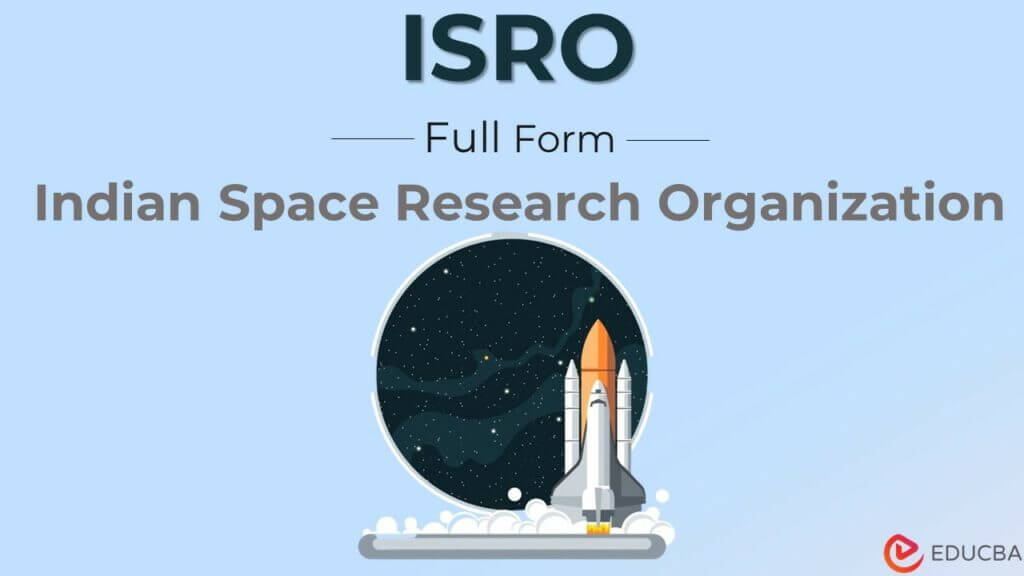Updated February 13, 2023
Full Form of ISRO (Indian Space Research Organization)
Full Form of ISRO is Indian Space Research Organization. The Indian Space Research Organization is the term of the Indian space agency (ISRO). It was set up as an offshoot of the Indian National Committee for Space Research (INCOSPAR) on August 15, 1969, and has been a part of the Department of Space (DOS) since 1972. The agency headquarters are in Bengaluru, Karnataka. Shri S. Somanath has been the Chairman of ISRO and the Secretary of the Department of Space since January 14, 2022.
ISRO was the dream of Dr. Vikram Ambalal Sarabhai, and this dream made many other dreams come true. From Aryabhata to PSLV-C54/ EOS -06, ISRO has launched 385 satellites for 34 different countries by November 26, 2022. Look at how the Indian Space Agency made history by becoming the first space agency to put a probe into orbit around Mars in its first attempt.
History of ISRO
From turning a bathroom into an operating system to setting up headquarters in Bengaluru, there is a long history of making ISRO the sixth-best space agency in the world for the following reasons:
- After the USSR launched the first artificial Earth satellite, Sputnik, in 1961, the then Prime Minister of India assigned the Department of Atomic Energy (DAE) to oversee space exploration.
- It marked the beginning of space technology. Veteran nuclear physicist Homi J. Bhabha founded the DAE and held the post of director.
- The Indian National Committee for Space Research (INCOSPAR) was in February 1962 by Homi J. Bhabha under the leadership of Vikram Sarabhai. INCOSPAR integrated into the Tata Institute of Fundamental Research (TIFR), led by MGK Menon.
- The team of rocket engineers included the 11th President of India, Dr. APJ Abdul Kalam. The committee decided to build the Thumba Equatorial Rocket Launching Station (TERLS) at Thumba, a fishing village not far from Thiruvananthapuram. Because of its proximity to the Earth’s magnetic equator, Thumba is an ideal location for rocket launches.
- INCOSPAR transformed into the Indian Space Research Organization (ISRO) in 1969. It became part of the Department of Space, established in 1972.
- ISRO had a modest start, marked by shoestring budgets and a lack of infrastructure. It partnered with Russia for its various early missions, but with the success of Aryabhata came the confidence and the desire to meet needs.
Objective of ISRO
In addition to creating goals for future astronauts and rocket scientists, ISRO has larger objectives for India.
- ISRO’s goal is to fully utilize space technology and use it for the advancement of the country.
- It intends to create and develop transportation solutions for the new space.
- Its objectives include developing, realizing, and building communication and observation satellites.
- ISRO aspires to train individuals and attract top minds to the space program.
- It seeks to broaden the appeal of space technology to young people.
- It aims to accelerate technological development and the introduction of new initiatives.
Achievements of ISRO
ISRO has achieved many milestones since the launch of Aryabhata on April 19, 1975.
- Chandrayaan-1, 2008: The Sanskrit name for moon craft is Chandrayaan. It is reportedly about a refrigerator’s size. Chandrayaan-1 Orbiter found evidence of the presence of water molecules on the moon.
- Mangalyaan, 2014: The Mars Orbiter Mission (MOM), also called Mangalyaan, was the first interplanetary mission carried out by India in 2014, and it made ISRO the fourth space organization to orbit Mars.
- IRNSS-1G: 2016 saw the debut of IRNSS-1G. It is the seventh and final satellite in the (IRNSS) Indian Regional Navigation Satellite System, a series following IRNSS-1A, IRNSS-1C, IRNSS-1B, IRNSS-1E, IRNSS-1D, and IRNSS-1F. The Indian region receives navigational services from this satellite constellation.
- SLV-3: The four-stage solid rocket Satellite Launch Vehicle-3 (SLV-3) was India’s first experimental launch vehicle. With the successful launch of the Rohini satellite ( RS -1) on July 18, 1980, from the Sriharikota Range (SHAR), India became the sixth member of a select group of space-faring countries.
Upcoming Projects of ISRO
The Indian Space Research Organization (ISRO) has been working to apply its technology to several national needs, and it aims to reach even greater heights in its future challenges. These are ISRO’s upcoming missions.
- Gaganyaan: The Gaganyaan mission will be India’s first space mission with a human team. By launching a crew of three people into a 400 km orbit for a three-day trip and returning them safely to the Earth by landing in Indian sea waters, the project aims to demonstrate the capacity of human spaceflight.
- Aditya – L1: Aditya L1 is a projected spacecraft by ISRO to research the solar atmosphere. It will investigate the solar atmosphere, solar magnetic storms, and their effects on the Earth’s environment. It will be India’s first solar mission.
- Chandrayaan-3: According to statements made by Union Minister Jitendra Singh in February of this year, Chandrayaan-3 is being developed based on lessons learned from the failure of Chandrayaan-2 and recommendations from some national-level specialists.
Conclusion – Full Form of ISRO
Space exploration has gained a privileged status owing to the unique technological and societal contributions it can offer. Through space exploration, India has solved various developmental challenges. Despite all of the benefits provided by ISRO, it is clear that a large portion of India still requires countless benefits from space applications and that more effort is to bring these benefits to broader sectors of society.
Recommended Articles
We hope that this EDUCBA information on “Full Form of ISRO” was beneficial to you. You can view EDUCBA’s recommended articles for more information,



